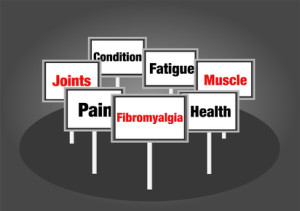 Fibromyalgia is a condition affecting approximately 2-4% of the population, most of them women, and is characterized by widespread chronic pain often accompanied by sleep disturbances, depression, moderate to extreme fatigue, sensitivity to light, sound and touch, and cognitive difficulties. Those who have fibromyalgia experience pain and tenderness at several points around the body that concentrate around the neck and shoulder region. Exercise and movement is helpful to manage the symptoms of fibromyalgia but has to be undertaken with care due to chronic pain and excessive fatigue that accompany this condition. An easy gentle yoga practice can be very helpful in assisting one with fibromyalgia by helping to control pain and increasing mood.
Fibromyalgia is a condition affecting approximately 2-4% of the population, most of them women, and is characterized by widespread chronic pain often accompanied by sleep disturbances, depression, moderate to extreme fatigue, sensitivity to light, sound and touch, and cognitive difficulties. Those who have fibromyalgia experience pain and tenderness at several points around the body that concentrate around the neck and shoulder region. Exercise and movement is helpful to manage the symptoms of fibromyalgia but has to be undertaken with care due to chronic pain and excessive fatigue that accompany this condition. An easy gentle yoga practice can be very helpful in assisting one with fibromyalgia by helping to control pain and increasing mood.
Yoga and meditation have been shown to help ease the pain of those suffering from fibromyalgia, yet the thought of any kind of exercise may not be appealing to those suffering from this often debilitating disease. Not all yoga is the same and there are precautions, as with any exercise, that one needs to be aware of when deciding to add yoga to their daily routine. Going to a yoga class in a studio or club may be too much to start with for someone with fibromyalgia. A simple breath practice in a reclining position for 5-10 minutes may be the perfect place to start. Slow deep breathing quickly signals the nervous system to relax and switch off the fight or flight response.
Fibromyalgia sufferers are thought to have lower pain thresholds and hypersensitive nervous systems where the brain is constantly being signaled to release stress hormones. High amounts of stress hormones over time result in changes to the body and brain leading to inflammation, a lowered immune response, and higher over-all disease rates. When the nervous system is always in fight or flight, the body and the mind hold tension, potentially triggering an attack of fibromyalgia and increasing the symptoms. The parasympathetic nervous system signals the relaxation response and the accompanying hormones are important for setting the stage for healing to take place.
Chronic pain often results in shallow breathing as well as limited movement. Starting with simple deep breathing and awareness techniques can go a long way to begin to relax the body and alleviate the pain associated with fibromyalgia. Quite often people with fibromyalgia have excess tension and pain the upper back, neck and shoulders. Learning to recognize held tension in the body and then learning how to release that tension with techniques of movement paired with breath can happen as one continues a mindful yoga practice.
 Several recent studies show that gentle yoga, both restorative and a slower paced flow style yoga, have been helpful in reducing pain and alleviating other symptoms of fibromyalgia. Studies show that people who practice yoga sleep better and have positive changes in mood, including less anxiety and depression. Yoga and meditation work by stimulating the vagus nerve, the main nerve of the parasympathetic nervous system and increasing the secretions of calming neurotransmitters such as dopamine, serotonin and more.
Several recent studies show that gentle yoga, both restorative and a slower paced flow style yoga, have been helpful in reducing pain and alleviating other symptoms of fibromyalgia. Studies show that people who practice yoga sleep better and have positive changes in mood, including less anxiety and depression. Yoga and meditation work by stimulating the vagus nerve, the main nerve of the parasympathetic nervous system and increasing the secretions of calming neurotransmitters such as dopamine, serotonin and more.
Get started now on the path to less pain. As little as 10 minutes a day may bring relief of many of the symptoms of fibromyalgia including reduced pain, increased mood, decreased anxiety and depression and better sleep!
Always consult your doctor before starting a yoga practice. It’s easy to go too far during class and then be sore the next day. Ease into an appropriate yoga practice and don’t be afraid to back off and give your muscles time to adapt. Listen to your body and focus on your breath to help guide your movement. Most importantly, find a teacher or yoga therapist that has experience working with individuals or groups with fibromyalgia to ensure a safe and effective program.
Kristy Manuel is a YogaFit Senior Master Trainer and Director of the YogaFit Therapy Program. She is an experienced yoga teacher, certified fitness trainer and wellness specialist with over 25 years experience in the fitness industry.
References:
Carson JW, Carson KM, Jones KD, Bennett RM, Wright CL, Mist SD. A pilot randomized controlled trial of the Yoga of Awareness program in the management of fibromyalgia. Pain. 2010;151(2):530–539.
Curtis K, Osadchuk A, Katz J, An eight-week yoga intervention is associated with improvements in pain, psychological functioning and mindfulness, and changes in cortisol levels in women with fibromyalgia. Journal of Pain Research. 2011;4: 189-201.
da Silva GD, Lorenzi-Filho G, Lage, LV. Effects of yoga and the Addition of tui na in patients with fibromyalgia. J Alt Complement Med. 2007;13(10):1107–1113.
Hennard J. A protocol and pilot study for managing fibromyalgia with yoga and meditation. International Journal of Yoga Therapy. 2011;21:109-121.
